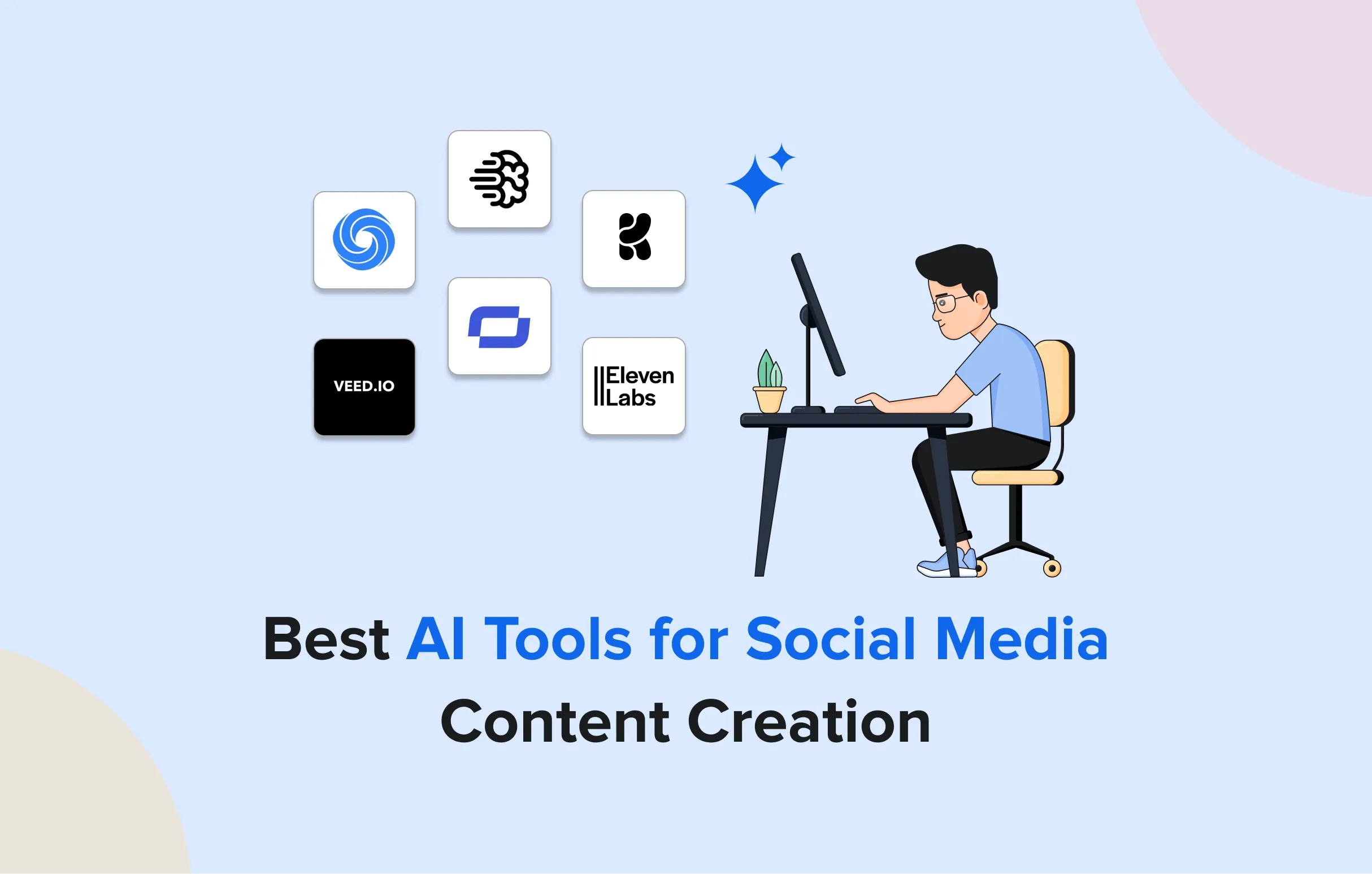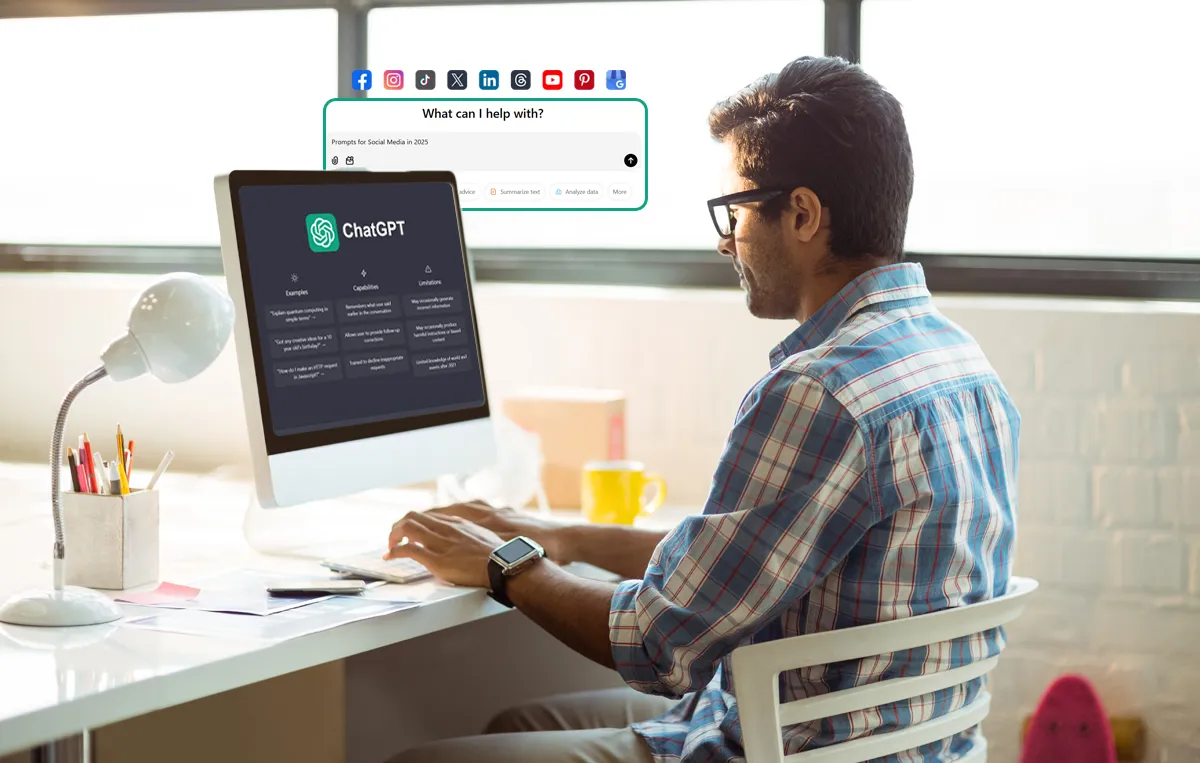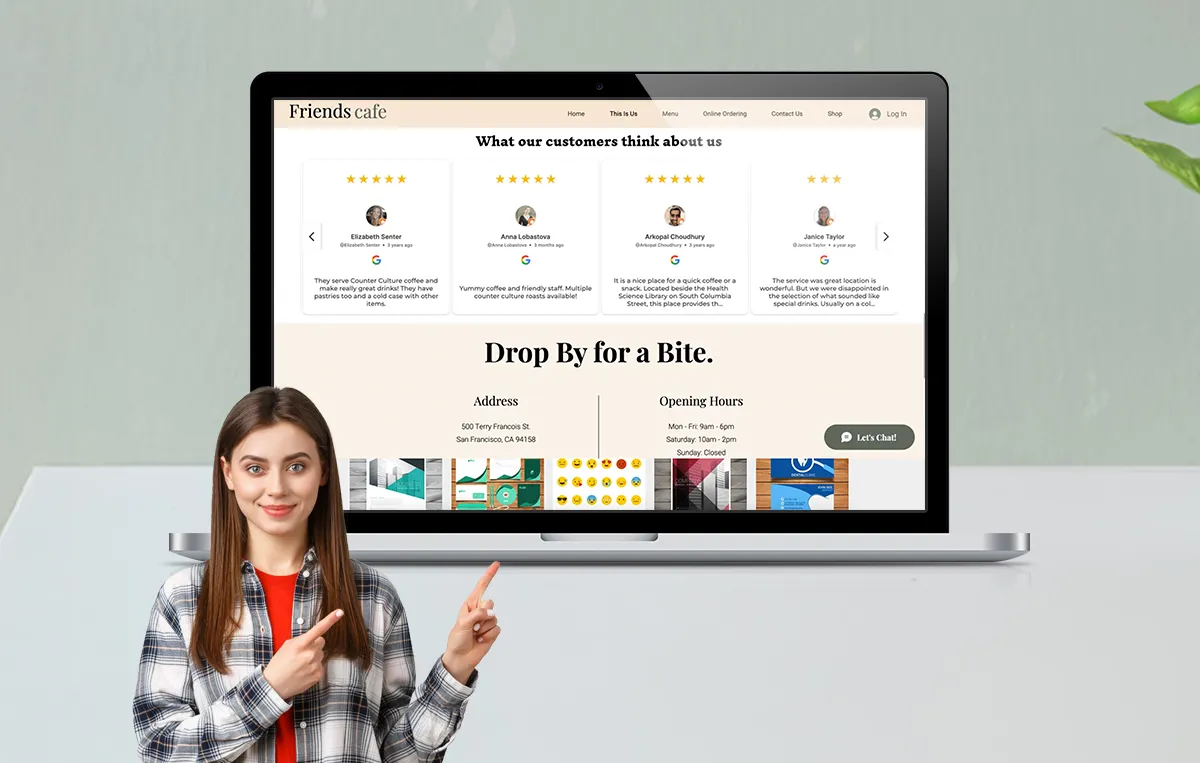In the ever-evolving AI-dominated digital world, the socialscape is where most of the marketing happens. And for e-commerce businesses that run on platforms like Shopify, having a social media presence is paramount.
If your presence is online, the place where most of your target audience spends the majority of their time is social media. So it makes complete sense that businesses using social media have gained up to 24% more new customers, with many receiving their first order within just 48 hours.
In this article, we’ll take you through every step of the journey, from establishing goals to assessing results.
So, let’s start the prep, shall we?
As a business owner who has established a store, online or not, you must’ve zeroed in on your target audience and current objectives. However, if you are about to launch your social media marketing, you need to re-evaluate your goals to develop a solid strategy.
Here are some elements to consider before you begin:
1. Define Clear and Measurable Goals
The end goal of any marketing done by a business is to bring in more sales and meet ROI targets. However, trying to get it all at once is not a wise decision for smaller businesses.
So it’s better to prioritize in the following chronological order:
- Identify one primary goal to guide your strategy for the next 3–6 months. (brand awareness, community building, sales boost, etc.)
- Come up with smaller supporting goals. For example, boosting unique views, reach, and new followers would be smaller goals to the overarching objective of building brand awareness.
- Set trackable and time-bound goals to achieve the smaller goals. For example, reach 500,000 unique accounts on Instagram in the next 60 days.
These feasible goals will help direct your content strategy when you get to it.
2. Target Audiences Based on Current ICP
As a business that has opened up shop already, you must already have your ICP figured out. Whether you offer products or services to B2B or B2C brands, creating a realistic customer persona is crucial.
If you don’t have valid social media insights on your ICP, you can still build a solid strategy by combining secondary research, behavioral assumptions, and competitor activities. Here are the steps to take when you want to start defining your target audience using strategic segmentation methods:
Define Your Ideal Buyer Persona
Start by defining who your ideal customer is. Consider demographic, psychographic, and behavioral factors based on industry research and assumptions. Even with no data, create customer personas based on what you know about your product and the market.
- Demographics: Age, gender, income level, location, and occupation.
- Psychographics: Interests, lifestyle, values (e.g., sustainability, fitness, luxury, etc.).
- Behavioral Patterns: Online purchasing behaviors, social media usage, engagement patterns, and content consumption.
Utilize Industry Data and Secondary Research
If you don’t have valid social media insights on your ICP, you can still build a solid strategy by combining secondary research and competitor activities.
- Competitor Analysis: Research competitors in your niche to understand who their audience is. Look at their social media engagement, follower demographics, content types, and audience interaction.
- Use Industry Reports: Leverage industry reports or market studies (e.g., from Statista, Pew Research, Hootsuite). This can give you broad insights into consumer trends and social media behavior.
Gather Your Own Data
Even if your e-commerce business is new, there is some grassroots-level research you can conduct to sharpen your focus on your ICP.
- Google Analytics: Even with a new store, Google Analytics provides key insights such as age, location, and interests, behavioural flow, and acquisition channels.
- Shopify Analytics: Shopify’s built-in analytics provides essential data such as purchase trends and inbound traffic sources.
- Google Trends: This free tool helps you tap into market demand and understand which topics and keywords are currently resonating with your target audience.
The most important decisions influenced by your Ideal Customer Profile (ICP) include platform selection, content strategy, and engagement style. As you begin your social media marketing activities, you will have the opportunity to refine your ICP based on firsthand insights, allowing you to further streamline your strategies.
If you think being omnipresent on social media is the way to win Shopify social media marketing, let us clear the air from the get-go— it’ll be wasted effort.
The majority of users on every social platform tend to skew in a certain direction depending on demographics. So you can pick the most popular platforms (Facebook, Instagram, and TikTok) based on those trends.
When choosing platforms to grow your Shopify store, remember:
- Whether you need to consider demographics or psychographics first depends on your business.
- Consider the intent of your ICP when they are using their preferred social media platform.
- In the beginning, go for no more than three social channels for your Shopify social media marketing.
- Don’t rely on guesswork, only data. Check your Shopify Analytics or Google Analytics to see which social sources send you traffic.
Here’s a realistic insight into how popular each social media platform is among US citizens:
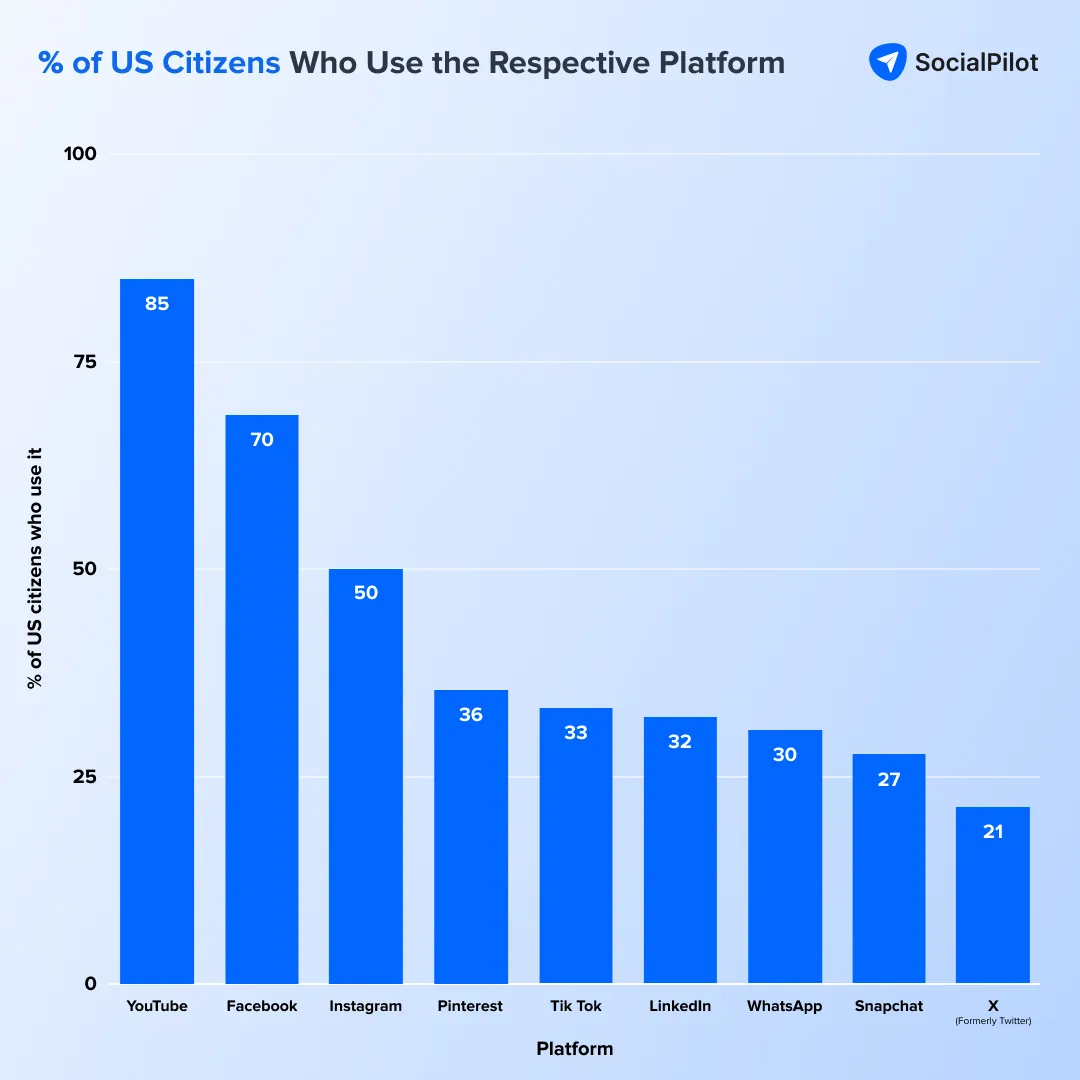
Here are some insights on the most popular social media platforms used by businesses for marketing purposes:
Monthly active users: 3.07 billion
Best for: B2C marketing
Facebook boasts the largest number of users across all age groups (not including YouTube). Also, it is the most preferred platform by millennials and Gen X, having its own space to host brands, i.e., Facebook Marketplace.
Monthly active users: 2 billion
Best for: B2C marketing
Being from the Meta family, Instagram has some shoppable features and is preferred for its visual and aspirational content. Reels get maximum reach among all the Instagram content formats, surpassing all types of static posts.
TikTok
Monthly active users: 1.59 billion
Best for: B2C marketing
When it comes to virality, TikTok is your best bet, delivering entertaining content to the younger demographics. Be it product discovery or starting trends, this platform leads the way. In fact, almost 77% of Gen-Z use TikTok for discovering new products, which is the starting touchpoint in a buyer’s journey.
Monthly active users: 537 million
Best for: B2C marketing
Females dominate the Pinterest user community, so it’s a space where small and niche businesses like art, home decor, and fashion can get substantial visibility.
YouTube
Monthly active users: 2.53 billion
Best for: B2C and B2B marketing
YouTube goes beyond entertainment—it’s a powerful tool for education, brand authority, and community building. Use it for product demos, how-tos, or webinars. With strong SEO and ad options, YouTube helps businesses boost visibility and drive conversions.
(Source: Statista)
4. Develop Your Unique Brand Personality
Now that you have defined the vital elements of your strategy, it’s time to carve out a personality for your brand.
If your online store is already open for business, you might have major branding components in place, such as logo, fonts, and colors. However, for a stark social media presence, the brand persona needs to be as crystal clear and memorable as an actual person.
So here is a structured approach to create a well-defined personality for your e-commerce business:
Brand Image
This is the aspect that represents what values and traits are the embodiment of your brand’s image. This helps maintain consistency in how you are perceived across various platforms, including social media and website interactions.
- Archetype: Choose a brand archetype to define your persona (e.g., The Hero, The Caregiver, The Rebel). This archetype helps communicate your core identity to your audience.
- Core Traits: Outline key characteristics like trustworthy, innovative, empathetic, or authoritative. These traits guide how your brand behaves in all communications and interactions.
- Public Face: Define how your brand would interact with customers—whether approachable, inspirational, or helpful—to create deeper emotional connections.
Brand Positioning
It highlights your unique value proposition and what makes your e-commerce business different from others. Positioning creates a distinct competitive edge for your brand, making it stand out.
- Value Proposition: Clearly articulate what makes your products unique—be it quality, pricing, or convenience—and why your target audience should choose you over competitors.
- Competitive Advantage: Position your brand in a way that emphasizes your strengths. This could be affordability, speed of service, or exclusive features.
Brand Voice
The brand voice is how your brand communicates—its tone, language, and style. It ensures all brand communications sound unified, regardless of platform or medium, and align with the emotional connection you want to create with customers.
- Tone: Set the emotional tone for communication (e.g., friendly, informal, professional, or empowering). The tone should align with both your ICP and your brand persona.
- Language Style: Choose whether your language will be conversational (informal), technical (precise), or inspirational (uplifting). This guides how you communicate complex product features or lifestyle-driven messages.
Brand Expressions
This is how your brand’s persona, voice, and messaging manifest across touchpoints like social media, website content, ads, and customer support.
- Visual Elements: Your logos, color schemes, and typography should be consistent with your brand persona and voice, ensuring your visuals reinforce the message and tone you’re conveying.
- Mascot: Having a mascot means creating an anthropomorphic and fictional character that brings your brand persona to life.
While creating your brand image, keep in mind that it has to resonate with your ICP.
5. Create Your Content Strategy
A consumer survey found that people choose brands on social media based on four things: the product, content quality, how quickly they respond, and customer reviews.
Now that you’ve nailed down the platforms and ICPs, it’s time to lock in your content marketing strategy. This is a crucial step that requires your special attention since the saying “Content is King” still holds true.
There are a couple of ways to build your content strategy before you start creating.
1. Align With Business Objectives
If you recall the main business objectives we had talked about in the very beginning, you can center your content around your main goal. The best-suited genre for three of the main business goals is:
- Brand Awareness : Educational, entertaining, and behind-the-scenes content
- Community Building : Interactive, user-generated, and relatable content
- Sales : Product demos, offers, testimonials, limited-time deals
2. Choose Themes According to Customer Journey
Create content that speaks to different stages of the buyer journey:
- Awareness: Educational tips, trending reels, myth-busting carousels, brand values, or origin stories.
- Consideration: Product comparison reels, FAQs, or carousel explainers, influencer reviews / UGC.
- Decision: Social proof/testimonials, product close-ups, use cases, flash sale countdowns.
3. Decide on Content Types Per Platform
Tailor formats to platform algorithms and audience expectations:
- Instagram: Reels, carousels, Stories, Guides
- TikTok: Trends, behind-the-scenes, challenges
- Pinterest: Product pins, infographics, step-by-step
- Facebook: Polls, live videos, long-form posts
- LinkedIn (if relevant): Thought leadership, company updates
4. Create a Balance of Evergreen and Trending Content
This is the easiest Shopify social media strategy for new brands that are just starting out with their social media marketing. A mix of evergreen brand-relevant content and the latest trends and styles, which have already been making the rounds online.
- Evergreen: Content that always applies (e.g., product promotion)
- Trends: Tap into what’s hot now (TikTok audio, Instagram trends)
5. Measure the Performance Consistently
Once your social media pages gain momentum, you will have firsthand results. You can adjust your content strategy accordingly, which is more effective than any assumptions.
- Use Platform-Specific Insights: Go to native analytics data from Facebook Audience Insights, Instagram Insights, or TikTok Analytics, or use social media analytics tools to examine how users interact with content on various platforms. Look for data on engagement rates, click patterns, and most active times for similar brands or products.
- Engagement Style Assessment: Assess whether your ICP prefers informational content, entertainment-driven content, or user-generated content. Respond to comments and direct messages to gather qualitative data about their likes, dislikes, and needs.
- Run Polls and Surveys: Use Instagram Stories polls, Twitter polls, or Google Forms to ask followers questions about their preferences and interests.
Before putting your strategy into motion, set up the stage, i.e., your profiles. Optimizing your social media pages before starting helps build a consistent and recognizable brand presence and trust with your audience. It also ensures your messaging is clear, laying the groundwork for better engagement and growth.
Here are the things to remember:
- Maintain consistency across platforms: Ensure your profile pictures, banners, and visuals align with your Shopify store’s branding. This creates a cohesive look across all platforms.
- Complete profile information: Fill out all necessary sections, such as your address, contact information, and links to other platforms. This enhances credibility and ensures users can easily connect with you.
- Clear and Compelling Bio: Craft a bio that tells your brand’s story in a concise, engaging way. Include a clear call-to-action (CTA) like “Shop now” or “Explore our collections” with a link to your Shopify store.
When you’re starting out, creating bulk content and posting it at the right times across platforms can be overwhelming, especially if you’re doing it all manually.
Thankfully, Shopify offers smart, AI-powered tools that take the heavy lifting off your plate. Let’s dive into the best ones to power up your social media game.
Rather than taking your products to the social media platforms, you can bring all your accounts to Shopify with SocialPilot. The integration acts as a scheduling tool, content manager, as well as an AI-powered content creator.
SocialPilot Shopify integration lets you connect multiple social media accounts to your store and schedule posts for them, which would then be automatically published.
However, the feature that makes SocialPilot the best integration for Shopify social media marketing is its AI-powered content creation capability. It can fetch products from your store and make them into posts, complete with AI-generated captions and authentic images.
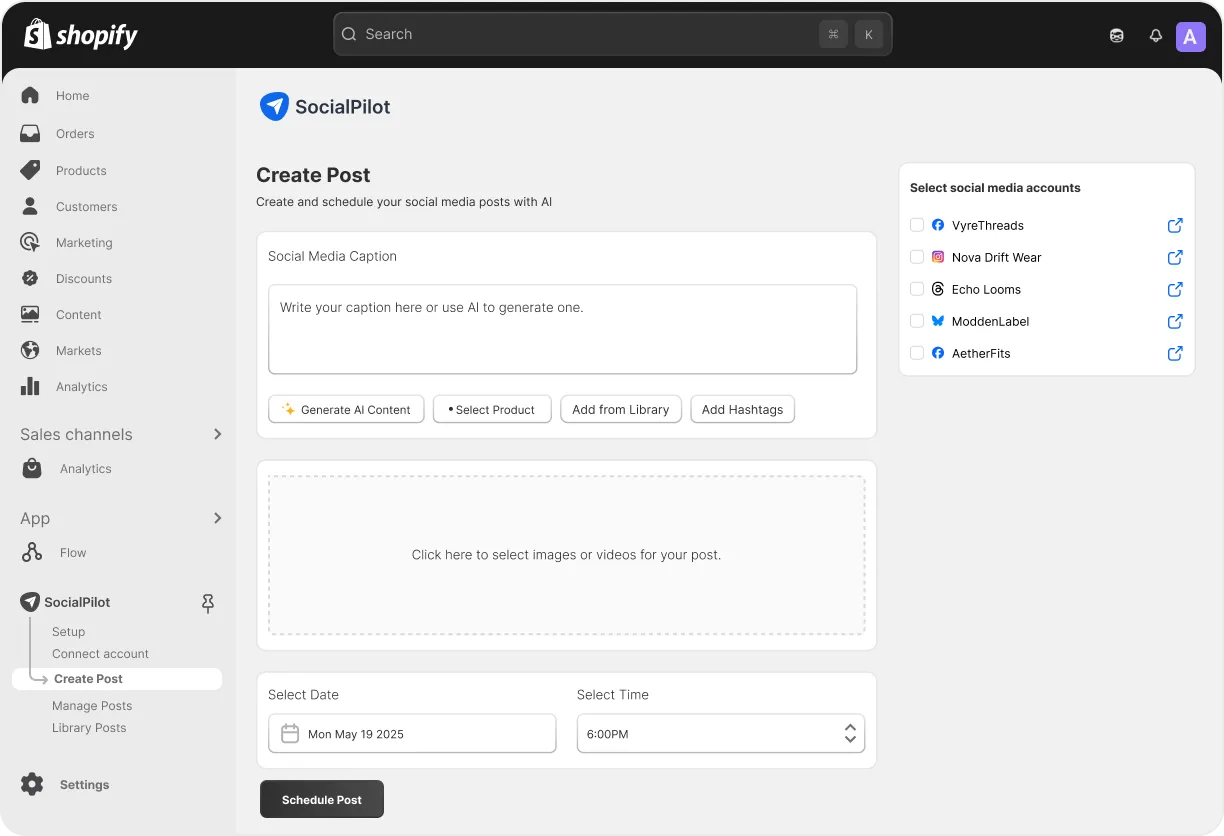
Here are the top features making SocialPilot the best Shopify social media integration:
- Unified Dashboard for Multi-Account Management: Manage and promote products across Instagram, Facebook, LinkedIn, and more—all from a single, easy-to-use dashboard.
- Seamless Shopify Integration: Connect your social channels directly from your Shopify dashboard—post, promote, and manage campaigns without ever leaving your store.
- AI-Powered Content Creation: Quickly generate captions and hashtags tailored to each product. Craft engaging, platform-specific content in seconds to boost visibility and interaction.
- Smart Post Scheduling: Automatically schedule content at optimal times across platforms to maximize reach and ensure your products show up when your audience is most active.
- Centralized Content Library: Retrieve content and hashtags in one place. Reuse and repurpose content to streamline your social media workflow.
When creating and publishing content becomes just a matter of a few clicks, maintaining consistency becomes easy. If you want to give your Shopify store the best boost possible, you can install SocialPilot integration within Shopify and try it for free.
Canva for Shopify
Canva itself is a popular design tool, with its versatile creation capabilities that serve to create all kinds of content for social media. The Canva Shopify integration similarly enables business owners to create stunning visual content directly from within their Shopify dashboard.
It offers thousands of customizable templates for Instagram posts, stories, reels, Facebook ads, and Pinterest pins — all optimized for social media. You can use these ready-made templates, combining them with your own product images to create branded posts. The drag-and-drop interface is powerful, and automatic resizing for different platforms makes it easy to produce professional-grade posts.
All these beginner-friendly features help you save time and money while being able to publish eye-catching content.
Promo.com
Video content is crucial for engagement, and Promo.com simplifies video production for Shopify marketers without needing advanced editing skills. A video creation platform integrated with Shopify, it helps merchants produce engaging short-form videos tailored for social media ads, reels, and stories.
Users can pull product info and images directly from Shopify, then craft compelling videos to showcase products or sales campaigns.
It offers a vast library of licensed music, video clips, and AI-powered tools to create dynamic product videos, promotional snippets, or customer testimonials — all optimized for platforms like Instagram, TikTok, Facebook, and YouTube.
This is a very unique Shopify integration that lets your customers share their shopping carts instantly across popular social media platforms like Instagram, Facebook, WhatsApp, Twitter (X), and more.
When customers share products from your e-commerce stores they’ve added to cart, they basically become your unpaid brand ambassadors.
For Shopify store owners, Keep & Share Your Cart offers a smart way to amplify word-of-mouth marketing and increase conversions without extra ad spend. The built-in cart recovery system reduces lost sales by re-engaging hesitant buyers. Marketers benefit from easy integration, customizable sharing buttons, and detailed analytics on cart shares and recovery rates.
So these Shopify apps are perfect for store owners who are starting out on social media, helping businesses drive sales organically in many ways.
Now the next move is to just get started creating and publishing.
Once you start posting on social media from your brand’s pages, don’t expect to see a sudden sharp spike in the referral traffic to your store or any unusual rise in the sales figures. Social media marketing can’t always work wonders as it takes some time and experimentation.
Once you have established consistency, you will get insightful results that you can use to adjust and improve your strategy. We do have some tricks up our sleeves for you to try so you can hit a home run quicker.
Your social profiles are the front door to your Shopify store on platforms like Instagram and Facebook. Optimizing them means making it dead simple for your followers to shop your products without friction.
This starts with turning on Instagram Shopping and linking your Facebook Shop directly to Shopify’s product catalog — so your posts and stories can tag products for instant checkout.
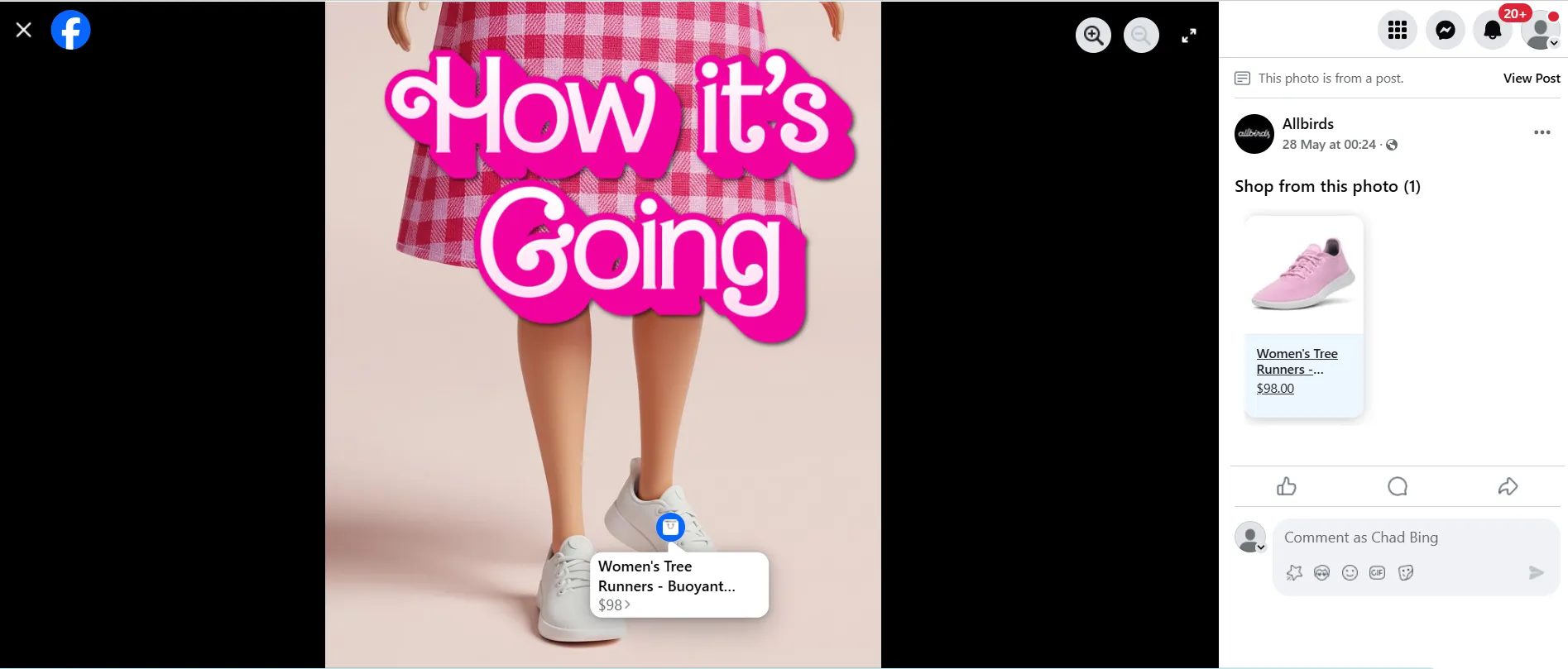
A great example is Allbirds, the sustainable footwear brand. They masterfully use Instagram Shopping with clean product tags that lead users straight to product pages, trimming down the path from discovery to purchase.
2. Create a Content Calendar Around Your Product Launches and Promotions
Strategic content planning keeps your Shopify store top of mind, especially during high-impact moments like launches or seasonal sales. Building a content calendar aligned with these key dates helps you orchestrate buzz, drip out sneak peeks, countdowns, and post-launch follow-ups, creating anticipation and urgency.
For small and medium Shopify merchants, it’s about pacing your posts to build hype without overwhelming your audience. Use calendar tools like Google Sheets or social schedulers like SocialPilot to map out posts weeks ahead.
3. Use Video Content to Showcase Your Products
Video content sees 49% more engagement than photos on social media, proving its success. Shopify stores that leverage video content, including demos, unboxings, tutorials, or customer stories, see much higher engagement and conversion rates.
Short-form videos like Instagram Reels and TikTok clips work especially well because they cater to shrinking attention spans and platform algorithms.
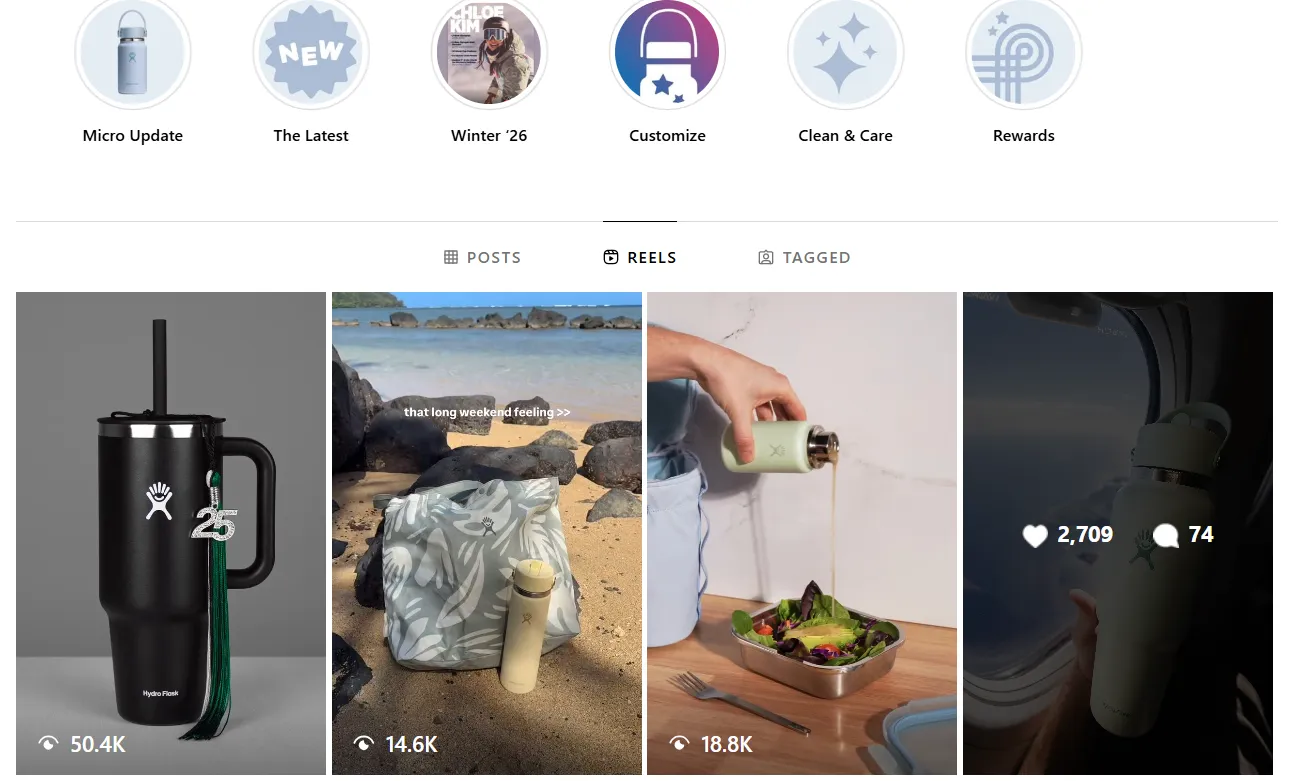
Even smaller Shopify brands like Hydro Flask nail video marketing by sharing lifestyle clips and content that sparks enthusiasm and community. A simple product intro reel has earned them more than fifty thousand views in less than a month, which is quite spectacular.
Now, in an effort to replicate this phenomenon, make sure videos are mobile-friendly, use captions for silent viewing, and end with a clear call-to-action like “Shop now” or “Link in bio.”
Hashtags remain a powerful organic tool for discovery and targeting on platforms like Instagram, TikTok, and Pinterest. The trick for Shopify marketers is to use a balanced mix of niche, branded, and trending hashtags that reflect your product and audience interests.
Avoid overloading posts with generic hashtags (#love, #follow), which dilute targeting. Use 5–10 highly relevant tags per post to ensure your content reaches the right eyes.
5. A/B Test Your Organic Posts
The term might be familiar in the context of paid ads, but that’s not all it is limited to. Shopify store marketers can boost organic performance by experimenting with different post formats, captions, CTAs, or posting times.
Testing reveals what resonates best with your specific audience — something generic social media advice can’t deliver. You can run simple A/B tests by posting similar content with slight variations spaced out in time or across different audience segments.
6. Schedule Posts for Optimal Times
Posting at the right time maximizes engagement, and scheduling tools help Shopify marketers maintain consistency without manual effort. Integrations like SocialPilot integrate seamlessly with Shopify, enabling you to queue posts across Instagram, Facebook, TikTok, and more.
All types of businesses, even small Shopify stores, can level up by scheduling posts during peak engagement hours identified via platform insights, rather than posting sporadically. Consistent and well-timed publishing signals to social algorithms that your brand is active, boosting organic reach and growing your store’s social presence steadily.
You can refer to our study to find the best times to post on every major social media platform.
7. Engage Actively With Your Community
Building a loyal following means more than just posting content — it’s about two-way conversations. Shopify merchants who actively respond to comments, DMs, and tagged posts turn casual followers into raving fans. Engagement boosts algorithm favor, so you get more visibility organically while cultivating trust.

Mejuri, a Shopify fine jewellery brand, is renowned for personalizing responses and interacting frequently with its community on Instagram. Their approachable tone and rapid replies create a VIP feel that builds brand affinity.
Now, it can get difficult if your engagement ball’s on a roll, but managing it is paramount. Set aside time daily (or delegate) to respond to questions, thank followers for positive comments, and even address concerns publicly with empathy. Use social listening tools to catch mentions you might otherwise miss.
Social proof is a powerhouse in e-commerce. E-commerce businesses that integrate customer reviews, testimonials, and user-generated content into their social posts and ads inspire confidence and drive conversions. Shoppers trust peer experiences far more than brand claims.
You can use review management tools like SocialPilot Reviews or similar Shopify integrations. They enable you to embed dynamic review widgets onto your website or even social share, i.e., share customer reviews on social media as posts.
Boost Your Reach with Influencer Collabs
Influencer marketing isn’t just for big brands — many Shopify stores thrive by collaborating with micro-influencers (1K–100K followers) who have engaged niche audiences. These partnerships drive authentic awareness and can deliver great ROI for social promotions.
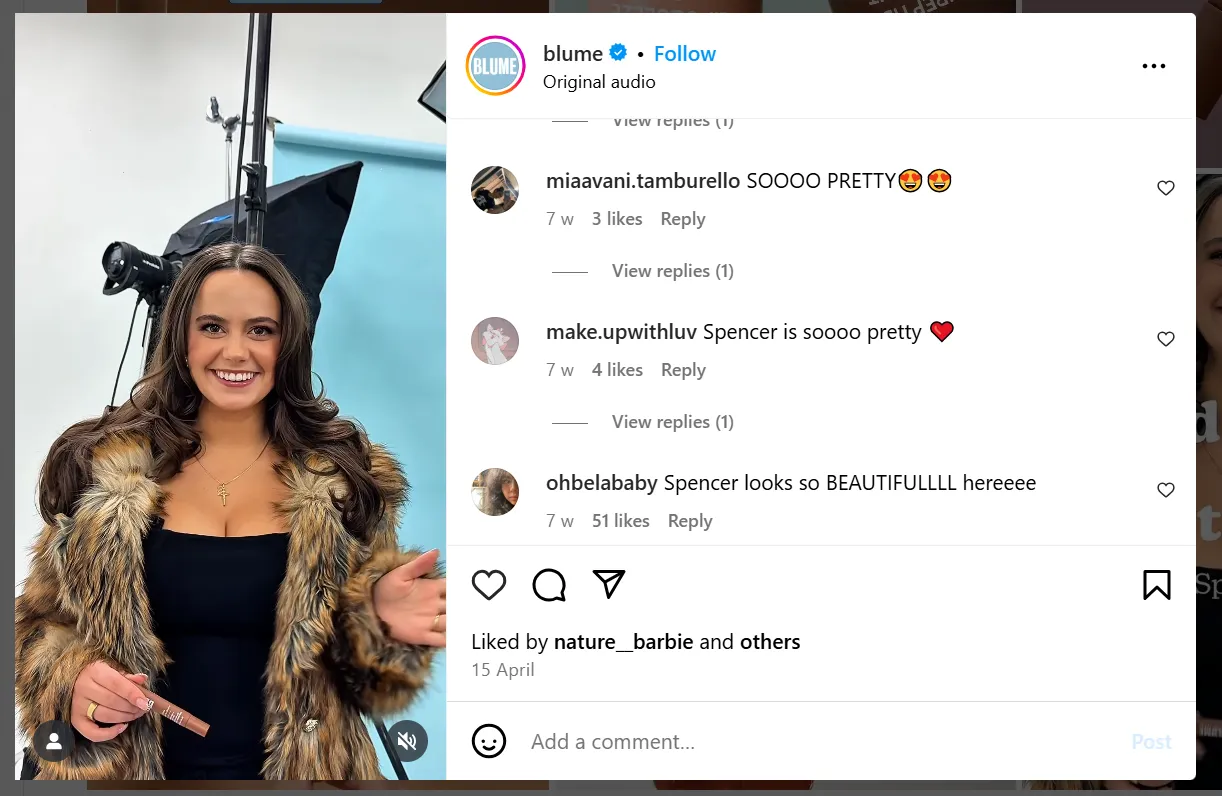
The surprising but organic collaboration between the beauty brand Blume and Spencer Barbosa is just the way to go. If a beloved personality’s name gets attached to your brand, all of their community is going to pay attention by default. And it goes without saying that your products get the added visibility, driving business ahead.
Mastering these social media strategies turns your Shopify store into a well-oiled marketing machine that attracts, engages, and converts.
To make the most of your social media marketing, it’s crucial to track and measure your social media ROI, i.e., how your efforts translate into store visits, engagement, and sales. These key metrics help you understand what’s working and where to focus your energy for the best returns.
Use Shopify’s built-in analytics and Google Analytics to see how much traffic each social platform drives to your store. Monitoring these numbers helps identify which channels bring the most visitors and potential customers.
Focus on how many social media visitors complete purchases or take key actions like signing up or adding to cart. Setting up conversion tracking links these sales directly to your social efforts, showing what’s truly driving revenue.
Analyze Engagement Metrics for Brand Awareness
Look beyond clicks and sales—track likes, comments, shares, and saves to measure how well your content resonates and builds brand visibility. High engagement often signals growing trust and a stronger connection with your audience.
Use UTM Parameters to Track Campaign Performance
Add UTM tags to social media links to precisely track which posts, ads, or campaigns drive traffic and sales. This detailed tracking allows you to fine-tune your strategy by focusing on the highest-performing content.
Tracking these metrics regularly gives you a clear picture of your social media marketing impact and helps you optimize campaigns for higher growth. Make measurement a habit to turn data into smarter decisions and stronger sales.
Conclusion: Build Your Shopify Brand
Social media marketing is essential for e-commerce businesses on Shopify that aim to drive sales in today’s digital landscape. You can create a powerful online presence that resonates by setting clear goals, understanding your audience, crafting a consistent brand voice, and leveraging the right platforms and content strategies.
From strategy creation up to implementation, managing social media marketing can be smoother with the help of the appropriate tools. If you want to experience advanced social media management at its finest, try out SocialPilot.
Don’t forget to track your results closely and optimize based on data. With patience, persistence, and a dynamic strategy, your Shopify store can turn social media into a thriving sales channel.


